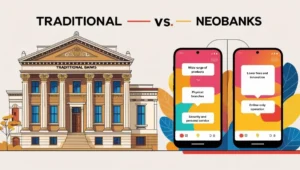Blockchain technology has emerged as a critical application in the last few years that has disrupted our conception of digital transactions and data handling. Not only we are going to explore the basics of blockchain, but we also delve into its application and utility, pros and cons, a challenge in execution and future.
What is Blockchain?
Decentralized digital ledger technology is a better expression since it outlines what it does and how: that people can share the same data all in real-time. To check the block size and calculate a new block, all nodes use cryptographic algorithms on it for that reason, scale chains competed to ensure similar finality between all copies of blocks.
Some key features of Blockchain
Decentralization: Prevents the risk of central failure, it is a departure from the traditional, centralized database model.
Transparency: all action taken on encompassing blocks are visible to every member, making it trust-increasing.
Irrevocability: A transaction isolated can be deemed inviolable, ensuring integrity of the data.
Efficiently Secure: Data is protected from both access and fraud by cryptographic techniques.
How Does Blockchain Work?
The Blockchain Structure
At the heart, a blockchain is a “chain” of blocks that consist of transaction data. Each block is furthermore connected to the preceding one, developing a “chain. So, let us get a less complex understanding of a blockchain:
Initiation of Transaction: A user initiates a transaction during usage.
Confirmation: It can be confirmed by the people who are concerned with it or in easy words it is verified by network nodes through the blockchain algorithms.
Block creation: the transaction is sorted along with other transactions in a new block after it has been checked true.
Link in Chain: The new block is added to the blockchain, and all the participants get a notification.
It indicates that there is no further adjustment, and the transaction is complete.
Potential of Blockchain Technology
There are many different industries in which blockchain can be put to good use:
Blockchain in the Financial Sector: It is in the financial sector, that the greatest impact is being made by blockchain technology. There are cryptocurrencies such as Bitcoin and Ethereum that use blockchain for conducting transactions in a secure and hidden manner. Even traditional banks and financial institutions are incorporating the use of blockchain technology in normal activities in a bid to enhance efficiency, reduce manipulation and win clients’ confidence.
Blockchain for the Healthcare Industry: Data relating to patients, is of utmost importance to medical practitioners, and as such, data reliability is critical. In this context, blockchain prevents the loss of patient records and enables the sharing of information amongst clinicians. This technology ensures that patient details are correct and are not overstated or changed by unauthorized persons which leads to higher quality services being rendered to the patients.
Blockchain in Real Estate: In real estate, blockchain is enhancing property transference and its trading offering a one-stop secure transction for property changinh hands. This can cut down the title investigation and renting out of the properties processes, which often are time-consuming and costly, in other ways as normal.
Applications of Blockchain in Digital Transactions
The application of blockchain technology does not limit to just the use of cryptocurrency only; its prospects go way further. Here are several key applications:
1. Transactions Using Cryptocurrencies: The majority of people associate the blockchain technology with cryptocurrencies such as Bitcoin and Ethereum. These virtual currencies make use of blockchain technology to make transactions between two parties directly and sans third-party intervention.
2. Smart Contracts: Smart contracts allow the inclusion of contract terms within the code that self-executes. It ensures adherence of the
agreements once preset conditions are satisfied eliminating undue delays in
various sectors including the construction and supply chain sectors.
3. Supply Chain Management: The introduction of the formulation of the blockchain technology enhances the visibility of the supply chains by offering all the parties a single version of the truth. As one goes through the supply chain, everything from a supplier to a distributor can be accounted for hence cutting down chances for misconducts.
4. Financial Services: The sector of banking is undergoing an evolution by the disruptor technologies regard dc web and blockchain in relevant industries. this allows cross-border payments to be made in less time and at a cheaper cost with minimal chances of fraudulent activities and facilitates regulatory compliance. More and more institutions are looking to offer similar services through a blockchain technology.
5. Validation of Digital Identity: Blockchains have the potential to simplify the process of identity verification by offering a safe, tamper-proof platform for storing and processing identity data. This is useful in areas like the financial services and health industries among others where identity verification is of utmost importance.
Benefits of Propagated Blockchain Technology
There is a wide variety and immense benefits of propagating Blockchain Technology, that set this transaction system apart from other conventional solutions, and makes it fit for business and customers alike.
Additional Level of Security: Because of the distributed characteristics and encompassing encryptions attached on every block, block chain is relatively more safe than traditional databases. The high level of security is timely as the world is witnessing an increase in cyber crimes.
Lower Costs: Cost of transactions these days is rather high due to third parties that act as intermediaries but with the introduction of block chain these costs are likely to reduce. This is actually very beneficial to those who are in business which has a small margin.
Better Time Management: Everyone hates taking too long to make payments and especially for service demand which is employment. Even as service delivery takes place, it is transformed from a manual to mechanized process whereby man does not have to validate, but rather systems do.
More Trust: The transparency and immutability of information fosters trust in all the persons that are involved. Organizations are able to give a guarantee to their customers that the operations they are performing are completely secure and traceable.
Common Issues Related to the Use & Implementation of Blockchain Technology
There are several challenges that trouble many sectors in integrating blockchain technology in their day-to-day operations
Apart from the Risks Involved
The first challenge stems from the advancement of the technology. The absence or ambiguity of some reasonable regulation may stop a company from implementing blockchain technology to its utmost potential.
Current Limitations Faced by Many Blockchain Networks
Most of the available blockchain networks are not able to scale effectively, particularly those that have adopted the Pow consensus model. The hassle of efficiency and speed as the number of transactions increases also enhances.
Gaps with the Current Technology and System Upgrade
Most of the firms have a problem of connecting the blockchain with the older systems they already have. There is great pressure on companies to change their systems to suit the growing demands of the world but at the same time making a smooth changeover.
Changing Climate
There are accusations leveled on the crypto networks that use PoW technology based blockchains concerning energy use. There are ongoing arguments on whether these technologies are here to last or if these greener ones are worth the hunt.
Where is Blockchain Technology Heading in the Future of Financial Transactions?
The relocation of polymeric materials is flourishing and there is even more healing in the future increasingly more new technologies. As further development comes in the technology, so do we foresee some of the issues being currently experienced being solved and more use cases being implemented.
1. Solutions for Interoperability: With the advancement of interoperability solutions, the interaction between different blockchain systems will become possible greatly extending their application in numerous sectors.
2. Regulatory Structures: Alluding to apparent consensus, when governments and regulatory institutions attain some understanding of the potential of blockchain, regulatory structures will take clearer shape which will promote its adoption.
3. Environmental Technologies: There will be more such energy-efficient blockchain applications inculcating the alternate PoS mechanisms and other energy-saving consensus protocols because of the developing trend towards green blockchains.
4. Universal Acceptance Across Sectors: Due to the growing ralization of the potential of blockchain, its application will be ny more sectors to usher in paradigm shifts in the current methods of transactions all over the world.
Conclusion
‘There has been an evolution in the way transactions are made, with the development of blockchain technology, which has enhanced security, efficiency, and openness. Its uses cut across all sectors, including finance and supply chain management, making it a victim of the digital economy. It would be incomplete to mention the conclusion without reiterating that the problems are present but the trends of the change and specialization of both companies and regulators give positive expectations regarding the development of such technology as blockchain.











